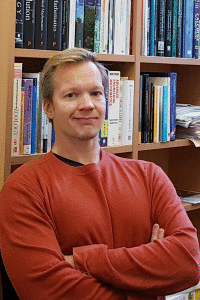Prior to 1970, most of the mathematical theory of evolution had been based on simplifying assumptions, resulting in models of the evolutionary process that were intended as (useful) approximations. In the late 1960s and early 1970s, George Price was taking a very different approach and thinking about the definition and very nature of selection in much more general terms [1]. As part of this project, Price published two papers [2,3] containing mathematical analyses of evolutionary change, with enduring influence in evolutionary theory. The first of these articles [2], barely exceeding one page in length, presented what is now known as the Price equation, a simple and exact description of evolutionary change in a population over a single generation. Although Price [2] derived his equation for the change in allele frequency, he emphasized that this was just one application of ‘a new mathematical treatment of selection in general’.
With slight alteration in notation compared to Price [2], his equation can be written as
| 1.1 |
where w is individual fitness, g is the frequency of the allele within an individual, overbars denote population averages and denotes deviation in allele frequency between parent and offspring. The first term on the right-hand side is the covariance, over all individuals in the population, between fitness and genotype, while the second term is a fitness-weighted average of the parent–offspring deviations. Thus, the equation decomposes the total change in allele frequency over a generation, , into two components, corresponding to natural selection and transmission bias, respectively. Note that if g were defined instead as a phenotypic value, then equation (I) would describe the change in mean phenotype over a generation. A derivation and introductory overview of equation (1.1) is presented by Gardner in this issue [4].
What makes the Price equation so general is its descriptive and almost retrospective nature, as well as its freedom from the simplifying assumptions of most evolutionary models. The equation is derived by assuming that we know the character value (e.g. genotype or phenotype) and offspring number of each parent, and the average character value of the set of offspring of each parent. The equation then yields an exact mathematical description of the evolutionary change between the parent and offspring populations, that holds true quite generally, and it expresses that change as the sum of two components which have natural biological interpretations. The ‘covariance' component measures the strength of natural selection on g, while the ‘expectation’ component captures the change that arises from transmission, e.g. because of mutation or non-Mendelian inheritance. There is no assumption of a direct causal relationship between parental character value g and fitness w. However, to transition from the exact Price equation to a less abstract model, we can substitute a specific model of the genotype–phenotype–fitness relationship into the equation (e.g. [5]).
One highly valued property of the Price equation is its great versatility, apparent from the breadth of topics covered in this issue of Philosophical Transactions B. Perhaps the first to see the importance of the Price equation was William Hamilton, who soon used the equation in a rederivation of central results in kin selection theory [6]. Kin selection and social evolution theory remain central applications of the Price equation, where the equation provides a general and unifying basis for alternative theoretical approaches [7]. Indeed Rice [8] shows how the Price equation can be made still more general, by deriving, without simplifying assumptions, a stochastic version of the equation in which fitness and offspring phenotype are treated as random variables rather than fixed quantities, with interesting applications to multivariate evolution.
It is rarely (if ever) the case that the Price equation is the only possible tool for getting the job done, but because the Price equation rests on minimal assumptions, it can be applied to an almost unlimited range of questions, and so helps to unify and connect different branches of evolutionary theory. Applications in this issue include relatively abstract topics such as the nature of selection and adaptation at the genic level [9], the concept of reproductive value [10] and the link between evolution and information theory [11]; more applied topics such as evolutionary epidemiology [12], human cultural evolution [13], the evolution of multicellularity [14] and non-genetic inheritance [15]; and empirically oriented topics such as animal breeding [16] and selection in wild populations [17].
The generality of the Price equation and its assumption-free nature lend it great flexibility, but also entail certain limitations. Whether these limitations are real drawbacks or simply inherent properties of this type of general theory will depend on one's perspective. The Price equation is a statistical summary of evolutionary change, and it is widely acknowledged that statistical relations do not necessarily imply or directly map onto causal relations. So, caution is required when making claims about causality based solely on the Price equation. Okasha and Otsuka [18] argue that the components of the Price equation have a clear causal meaning only when interpreted in the context of an explicit causal model, and that further assumptions are needed in order to separate the roles of selection and transmission as causes of evolutionary change. Similarly, Van Veelen [19] argues that extra assumptions are needed for meaningful interpretation of the Price equation, and, furthermore, that failure to recognize limitations of the Price equation has been damaging to the field of social evolution.
George Price was an unusual character in the history of evolutionary biology. He was trained as a chemist, and even worked on the Manhattan project [20–22], taking up evolutionary biology in his forties at the Galton Laboratories in London. He published few papers in his new profession, but they had a lasting influence. Besides the Price equation, he had a central role in bringing the methods of game theory to the study of animal behaviour [23]. Evolutionary game theory was to become a fundamental aspect of theoretical evolutionary biology during the next decade [24]. Price also contributed to our understanding of Fisher's fundamental (but elusive in its meaning) theorem of natural selection [25]. He had started to sketch an outline of a general theory of selection, which he saw as analogous to the birth of information theory [26]. However, this work was published posthumously two decades after Price's death [1].
Sadly, Price did not live to see how important his work would become. In his last years, he converted to evangelical Christianity, gave up research in biology and turned instead to biblical scholarship. He took altruism to an extreme and began helping the homeless of London, ending up penniless and destitute. George Price was found dead in January 1975, having taken his own life, but his legacy lives on.
Biographies
Editor biographies
 Jussi Lehtonen received his doctorate in evolutionary biology and ecology in 2013 from the Australian National University. He is currently an Australian Research Council DECRA fellow at the University of Sydney. Jussi has a long-standing interest in mathematics and the various ways mathematical methods can be applied to biological questions, ranging from abstract and theoretical topics to applications on specific biological questions, particularly in evolutionary biology and its interface with ecology.
Jussi Lehtonen received his doctorate in evolutionary biology and ecology in 2013 from the Australian National University. He is currently an Australian Research Council DECRA fellow at the University of Sydney. Jussi has a long-standing interest in mathematics and the various ways mathematical methods can be applied to biological questions, ranging from abstract and theoretical topics to applications on specific biological questions, particularly in evolutionary biology and its interface with ecology.
 Samir Okasha is a professor of Philosophy of Science at the University of Bristol, UK. He received his doctorate in 1998 from the University of Oxford. His research interests focus on philosophical, methodological and conceptual issues in the natural sciences, in particular evolutionary biology. He also researches epistemological issues concerning the nature of scientific inference, inductive reasoning and causality.
Samir Okasha is a professor of Philosophy of Science at the University of Bristol, UK. He received his doctorate in 1998 from the University of Oxford. His research interests focus on philosophical, methodological and conceptual issues in the natural sciences, in particular evolutionary biology. He also researches epistemological issues concerning the nature of scientific inference, inductive reasoning and causality.
 Heikki Helanterä got his PhD in ecology and evolutionary biology at the University of Helsinki in 2005 and had been working at the Universities of Helsinki, Sheffield and Sussex before starting as an associate professor (tenure track) in evolutionary genomics at the University of Oulu, Finland, in 2018. His main research interest is social evolution. His research combines population genetic, genomic, ecological and behavioural work especially on ants, as well as theoretical evolutionary studies more generally. (Photo credit: Krista Mäkinen).
Heikki Helanterä got his PhD in ecology and evolutionary biology at the University of Helsinki in 2005 and had been working at the Universities of Helsinki, Sheffield and Sussex before starting as an associate professor (tenure track) in evolutionary genomics at the University of Oulu, Finland, in 2018. His main research interest is social evolution. His research combines population genetic, genomic, ecological and behavioural work especially on ants, as well as theoretical evolutionary studies more generally. (Photo credit: Krista Mäkinen).
Data accessibility
This article has no additional data.
Authors' contributions
All authors contributed equally.
Competing interests
We declare we have no competing interests.
Funding
J.L. is funded by an Australian Research Council Discovery Early Career Research Award (project number DE180100526) from the Australian Government.
References
- 1.Price GR. 1995. The nature of selection. J. Theor. Biol. 175, 389–396. ( 10.1006/jtbi.1995.0149) [DOI] [PubMed] [Google Scholar]
- 2.Price GR. 1970. Selection and covariance. Nature 227, 520–521. ( 10.1038/227520a0) [DOI] [PubMed] [Google Scholar]
- 3.Price GR. 1972. Extension of covariance selection mathematics. Ann. Hum. Genet. 35, 485–490. ( 10.1111/j.1469-1809.1957.tb01874.x) [DOI] [PubMed] [Google Scholar]
- 4.Gardner A. 2020. Price's equation made clear. Phil. Trans. R. Soc. B 375, 20190361 ( 10.1098/rstb.2019.0361) [DOI] [PMC free article] [PubMed] [Google Scholar]
- 5.Queller DC. 2017. Fundamental theorems of evolution. Am. Nat. 189, 345–353. ( 10.1086/690937) [DOI] [PubMed] [Google Scholar]
- 6.Hamilton WD. 1970. Selfish and spiteful behaviour in an evolutionary model. Nature 228, 1218–1220. ( 10.1038/2281218a0) [DOI] [PubMed] [Google Scholar]
- 7.Lehtonen J. 2020. The Price equation and the unity of social evolution theory. Phil. Trans. R. Soc. B 375, 20190362 ( 10.1098/rstb.2019.0362) [DOI] [PMC free article] [PubMed] [Google Scholar]
- 8.Rice SH. 2020. Universal rules for the interaction of selection and transmission in evolution. Phil. Trans. R. Soc. B 375, 20190353 ( 10.1098/rstb.2019.0353) [DOI] [PMC free article] [PubMed] [Google Scholar]
- 9.Queller DC. 2020. The gene's eye view, the Gouldian knot, Fisherian swords and the causes of selection. Phil. Trans. R. Soc. B 375, 20190354 ( 10.1098/rstb.2019.0354) [DOI] [PMC free article] [PubMed] [Google Scholar]
- 10.Grafen A. 2020. The Price equation and reproductive value. Phil. Trans. R. Soc. B 375, 20190356 ( 10.1098/rstb.2019.0356) [DOI] [PMC free article] [PubMed] [Google Scholar]
- 11.Frank SA. 2020. Simple unity among the fundamental equations of science. Phil. Trans. R. Soc. B 375, 20190351 ( 10.1098/rstb.2019.0351) [DOI] [PMC free article] [PubMed] [Google Scholar]
- 12.Day T, Parsons T, Lambert A, Gandon S. 2020. The Price equation and evolutionary epidemiology. Phil. Trans. R. Soc. B 375, 20190357 ( 10.1098/rstb.2019.0357) [DOI] [PMC free article] [PubMed] [Google Scholar]
- 13.Nettle D. 2020. Selection, adaptation, inheritance and design in human culture: the view from the Price equation. Phil. Trans. R. Soc. B 375, 20190358 ( 10.1098/rstb.2019.0358) [DOI] [PMC free article] [PubMed] [Google Scholar]
- 14.Shelton DE, Michod RE. 2020. Group and individual selection during evolutionary transitions in individuality: meanings and partitions. Phil. Trans. R. Soc. B 375, 20190364 ( 10.1098/rstb.2019.0364) [DOI] [PMC free article] [PubMed] [Google Scholar]
- 15.Helanterä H, Uller T. 2020. Different perspectives on non-genetic inheritance illustrate the versatile utility of the Price equation in evolutionary biology. Phil. Trans. R. Soc. B 375, 20190366 ( 10.1098/rstb.2019.0366) [DOI] [PMC free article] [PubMed] [Google Scholar]
- 16.Bijma P. 2020. The Price equation as a bridge between animal breeding and evolutionary biology. Phil. Trans. R. Soc. B 375, 20190360 ( 10.1098/rstb.2019.0360) [DOI] [PMC free article] [PubMed] [Google Scholar]
- 17.Hajduk GK, Walling CA, Cockburn A, Kruuk LEB. 2020. The 'algebra of evolution': the Robertson–Price identity and viability selection for body mass in a wild bird population. Phil. Trans. R. Soc. B 375, 20190359 ( 10.1098/rstb.2019.0359) [DOI] [PMC free article] [PubMed] [Google Scholar]
- 18.Okasha S, Otsuka J. 2020. The Price equation and the causal analysis of evolutionary change. Phil. Trans. R. Soc. B 375, 20190365 ( 10.1098/rstb.2019.0365) [DOI] [PMC free article] [PubMed] [Google Scholar]
- 19.van Veelen M. 2020. The problem with the Price equation. Phil. Trans. R. Soc. B 375, 20190355 ( 10.1098/rstb.2019.0355) [DOI] [PMC free article] [PubMed] [Google Scholar]
- 20.Frank SA. 1995. George Price's contributions to evolutionary genetics. J. Theor. Biol. 175, 373–388. ( 10.1006/jtbi.1995.0148) [DOI] [PubMed] [Google Scholar]
- 21.Harman O. 2010. The Price of altruism: George Price and the search for the origins of kindness. New York, NY: W. W. Norton. [Google Scholar]
- 22.Harman O. 2020. When science mirrors life: on the origins of the Price equation. Phil. Trans. R. Soc. B 375, 20190352 ( 10.1098/rstb.2019.0352) [DOI] [PMC free article] [PubMed] [Google Scholar]
- 23.Maynard Smith J, Price GR. 1973. Logic of animal conflict. Nature 246, 15–18. ( 10.1038/246015a0) [DOI] [Google Scholar]
- 24.Maynard Smith J. 1982. Evolution and the theory of games. Cambridge, UK: Cambridge University Press. [Google Scholar]
- 25.Price GR. 1972. Fisher's ‘fundamental theorem' made clear. Ann. Hum. Genet. 36, 129–140. ( 10.1111/j.1469-1809.1972.tb00764.x) [DOI] [PubMed] [Google Scholar]
- 26.Shannon CE. 1948. A mathematical theory of communication. Bell Syst. Tech. J. 27, 379–423. ( 10.1002/j.1538-7305.1948.tb01338.x) [DOI] [Google Scholar]
Associated Data
This section collects any data citations, data availability statements, or supplementary materials included in this article.
Data Availability Statement
This article has no additional data.


